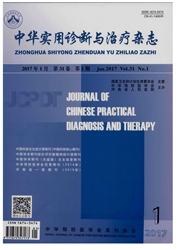

 中文摘要:
中文摘要:
目的:探讨血清蛋白质指纹图谱用于胃癌早期诊断的可行性。方法:用弱阳离子交换芯片蛋白芯片结合表面增强激光解吸电离飞行时间质谱技术检测血清蛋白质指纹图谱。以30例胃癌(10例早期、14例进展期、6例伴远隔脏器转移)与30例正常对照为训练组建立早期胃癌决策树分类器模型,并用盲筛方法对未参加建模的27例胃癌患者及7例良性病、19例健康者进行验证。结果:初步建立了3个对早期胃癌诊断预警分类效果较好的模型,参加盲筛的9例早期胃癌患者均被准确鉴别,模型的总体敏感性96.3%,特异性73.1%~84.6%;阴性预测值94.7%~95.7%;阳性预测值78.9%~86.7%。结论:虽然本实验建立的用于胃癌患者早期诊断预警模型在与胃良性病鉴别上效果不理想,但可有效用于人群中的早期胃癌初步筛查,有进一步研究的价值。
 英文摘要:
英文摘要:
Objective To study the feasibility of the serum protein fingerprint for the early diagnosis of gastric cancer. Methods The serum protein fingerprint was screened with surface-enhanced laser desorption ionization mass spectrometry and Protein-Chip technology, and coupled with a pattern matching algorithm and serum samples. Thirty patients with gastric cancer (10 in early stage, 14 advanced, 6 with distant metastasis) and 30 normal subjects were included to construct the decision-tree classifier models. The specificity of model was tested with the blind set in 27 patients with gastric cancer, 7 gastric benign lesions and 19 healthy controls. Results Three decision-tree classifier models had been constructed, among which, all of the 9 early gastric cancer patients in the blinding test group were identified accurately. These results of test with blind set displayed that its sensitivity was 96.3%, specificity 73. 1%-84.6%, negative predicting value 94.7%-95.7%, and positive predicting value 78. 9 % - 86.7 %. Conclusion There is still some extent limitation for three decision-tree classification models to identify the gastric cancer from gastric benign lesion, but they can be effectively used for screening early gastric cancer from crowd. It is worthy of further study.
 同期刊论文项目
同期刊论文项目
 同项目期刊论文
同项目期刊论文
 期刊信息
期刊信息
